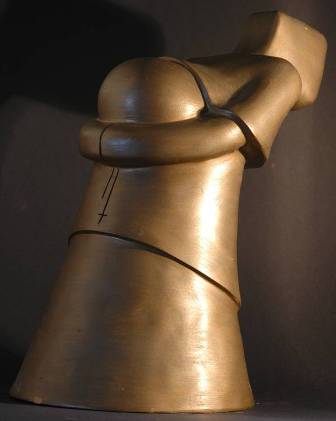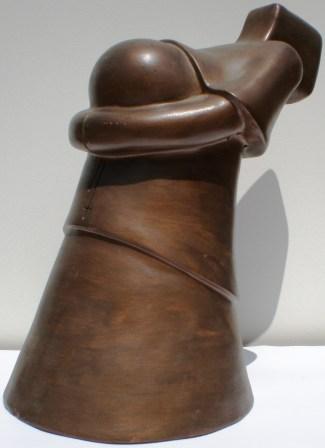
La scultura di forma conoidale, essenziale e disadorna, raffigura un prete nell’atto di donare al cielo la sua “pancia” adiposa quasi fosse un cerimoniale, un atto di devozione, una liturgia. Sbilanciata all’indietro, ma ben ancorata a terra dal contrappeso della “pancia”e dalla larghezza dell’abito talare. Non ha un volto definito e pochi elementi identificano il soggetto, come la corona con il crocifisso inciso. Questa indefinitezza vuole traslarne il significato allegorico a quanti navigano nell’abbondanza, insensibili ai patimenti del mondo.
La “pancia” così in evidenza diventa emblema delle “incongruenze” che si insinuano nelle profonde pieghe della Chiesa. La “pinguedine” di alcuni uomini di fede, che citano in latino il volere di Dio, ha sempre suscitato molto interesse nell’autore. Pasciuti e opulenti, anche nella cultura che ostentano, stabiliscono distanze culturali nei confronti di chi crede con sincerità nell’amore e nella misericordia.
Priest who gives wealth-Pasquale Mastrogiacomo
The sculpture shaped cone, basic, unadorned, depicts a priest in the act of giving the sky its “belly” fat almost like a ritual, an act of devotion, a liturgy. Unbalanced back, but well anchored to the ground by the counterweight of the “belly” and the width apparel cassock. It has a face and a few defined factors identifying the subject, as the crown with the crucifix engraved. This indefiniteness want to translate the allegorical meaning to those who sail in abundance, insensitive to the sufferings of the world.
The “belly” so clearly becomes an emblem of “inconsistencies” that creep into the deep folds of the Church. The “fatness” of some men of faith, citing the will of God in Latin, has always aroused great interest in the author. Fed and opulent, even that flaunt in the culture, establish cultural distances to those who sincerely believe in love and mercy.
